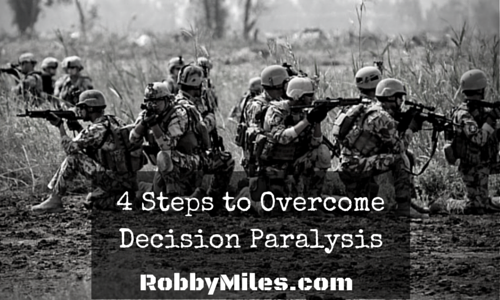You’ve had the experience…That gut-wrenching, sinking feeling, when you know something horrible is about to happen. It’s paralyzing. However, the military has a way of training Soldiers to overcome this paralysis on Day 1 of Basic Training: The “Shark Attack.”

All Soldiers have shared the experience of Drill Sergeants flooding the bus in rampage, screaming and shouting directions. Different trainers yell conflicting commands. Soldiers have to act immediately and make quick decisions to avoid the Drill Sergeants’ wrath. Have you ever felt pulled in different directions not knowing which decision to make? Below you’ll find four steps Soldiers use to overcome decision paralysis.
Step 1: Identify The Problem
Have you ever begun a project only to get halfway through and realize you were working in the wrong direction? You likely failed to identify the problem. Drill Sergeants purposely find problems to confront their Soldiers and force problem recognition.
They then introduce pressure through shortened timelines while yelling and disrupting the process. This intense situation is designed to prepare Soldiers for the battlefield by simulating “the fog of war.” The pressure forces Soldiers to understand exactly what needs to be accomplished.
I’ll share one story from Officer Candidate School when I was leading my squad on a reconnaissance mission. We set out from our patrol base to an objective 700 meters away. After traveling approximately 200 meters, the enemy ambushed my squad. I had to identify the problem in mere seconds and act appropriately. By identifying enemy locations, I could effectively plan my squad’s response. One problem I still faced was having too many options.
Step 2: Think in Terms of “This or That”
Immediately upon taking fire I had to get my squad to safety while maintaining command and control. All Soldiers are trained to return fire and find cover when taking fire. As their leader, I had to assess the situation and make a quick decision about how to react.
It helped to think in terms of this or that. Quickly narrow down options to two. It was so easy to get bogged down by thinking about all the possibilities.. Here are the questions I used to narrow my choices:
- Is the choice reasonable?
- Is the choice simple enough to communicate efficiently and effectively?
- Is this a choice I would actually make or am I wasting my time by procrastinating?
I saw two clear choices. My squad could:
- hold our ground, fight back, and wait for reinforcements. OR
- assault the enemy, take their position, and wait for reinforcements.
Narrowing my options made the decision easier. It eliminated gray areas on a battlefield of black and white.
Step 3: Embrace The Possibility of Failure
Fear of failure is one of the main reasons we put off making decisions. Nobody wants to make a poor choice and deal with the consequences. Making decisions and taking action requires a certain level of risk. Not all risk is bad. Each day we accept certain risks: driving to work, eating, loving. But, we accept risk knowing that the reward is greater.[shareable cite=”Robby Miles”]Accept risk knowing that the reward is greater.[/shareable]
In my mission, both options could have led to failure. I could lose Soldiers in a prolonged firefight. Reinforcements might take too long. What if I was injured, or worse? By embracing the possibility of failure, I accepted the necessary risk and took action. The words of CPT Ronald Spiers as depicted in the HBO mini-series Band of Brothers resonated with me,
The only hope you have is to accept the fact that you’re already dead. The sooner you accept that, the sooner you’ll be able to function as a soldier is supposed to function. ~ CPT Ronald Spiers
Embracing the possibility of failure up to and including death clears the mind and facilitates quicker more efficient decision-making. All that was left: taking action.
Step 4: Trust Your Intuition or Gut Instinct
I’d Identified the problem, thought in this or that terms, and accepted the possibility of failure. I considered my two options and took the leap using my training and instinct as a guide. I had to lead a charge against the enemy. I had to surprise them. I had to take the high ground and save my Soldiers.
“Trust your gut.” How many times have you heard that? It turns out that your gut acts as a second brain. Instinct is developed over time through training. Your muscles build a memory (just think about your reaction last time you dropped your phone). Your brain and instincts are no different.
Soldiers are taught to “train as we fight.” By exercising our instinct, we are prepared to rise to any occasion.
The military has a way of training Soldiers to overcome decision paralysis. The “Shark Attack” is just the beginning. Sometimes it is hard to identify the problem and look at problems in this or that terms. But once we embrace the possibility of failure, we become invincible. At some point, we just have to act.
[reminder]What step do you find the hardest to overcome?[/reminder]
